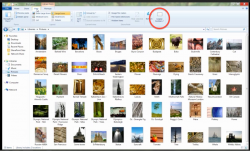I know it's a Mac forum, but this isn't meant as a PC vs Mac debate. Obviously Windows 8 is still in development, but Microsoft has a blog where they are tracking the status and development of features in their next OS. Obviously it's hard to say how it will all feel in the end, but it's interesting nonetheless to hear the thought process being put into these features.
There was a recent blog post on Windows Explorer: http://blogs.msdn.com/b/b8/archive/2011/08/29/improvements-in-windows-explorer.aspx
I know not everyone is a fan of the Ribbon interface. But of those who use it, I think it definitely makes certain tasks easier and makes a user more aware of features that they previously didn't know existed. So it's interesting they are finally integrating it into Windows Explorer. It makes sense considering they've been doing that to other applications over the last few years with some programs. But the bigger benefit I think here will be how it gets used it a touch-enabled device.
Obviously Windows 7 as it stands has touch features but isn't really optimized for touch. Windows 8 looks to fix that with a new GUI specifically for touch, but it's also going to allow the user to go back into normal desktop view most are familiar with. So when going back into that desktop view, it will certainly be easier dealing with the Ribbon rather than drop down menus.
The blog post is pretty long and does a good job explaining what their doing and why. I won't go more into it, but I'm curious to hear your thoughts on this change. I know Apple during the development of OS X Lion was pretty hush about showing changes and features. However a few did get leaked out and caused some chatter as expected. In some cases, Apple simply went back to the way it was (the one feature that comes to mind is buttons and how it was greyed out to indicate selections and how it would behave when sliding, I forget exactly what happened but I know they reverted back over three developer previews if I'm not mistaken). In other cases they made GUI changes (with the option to change it back as well) such as the fading scroll bar, reversing how one scrolls on a mouse, etc. At a high level, I can understand why they've gone this route since they are trying to create familiar experience across different devices (OS X and iOS). And it looks like Microsoft is doing the same.
I don't think it's a bad decision on either company's part either. It's just the natural progression of things, but how they go about it will certainly be important. At the end of the day, a desktop is a desktop and a tablet is a tablet. There are only so many changes you can make to the GUI to make it a one size fits all or to maintain familiarity that doesn't end up annoying end users.
What do you think based on the changes described in the blog post? Will this alienate you as a Windows user or are you pretty open to try out these new changes?
There was a recent blog post on Windows Explorer: http://blogs.msdn.com/b/b8/archive/2011/08/29/improvements-in-windows-explorer.aspx
I know not everyone is a fan of the Ribbon interface. But of those who use it, I think it definitely makes certain tasks easier and makes a user more aware of features that they previously didn't know existed. So it's interesting they are finally integrating it into Windows Explorer. It makes sense considering they've been doing that to other applications over the last few years with some programs. But the bigger benefit I think here will be how it gets used it a touch-enabled device.
Obviously Windows 7 as it stands has touch features but isn't really optimized for touch. Windows 8 looks to fix that with a new GUI specifically for touch, but it's also going to allow the user to go back into normal desktop view most are familiar with. So when going back into that desktop view, it will certainly be easier dealing with the Ribbon rather than drop down menus.
The blog post is pretty long and does a good job explaining what their doing and why. I won't go more into it, but I'm curious to hear your thoughts on this change. I know Apple during the development of OS X Lion was pretty hush about showing changes and features. However a few did get leaked out and caused some chatter as expected. In some cases, Apple simply went back to the way it was (the one feature that comes to mind is buttons and how it was greyed out to indicate selections and how it would behave when sliding, I forget exactly what happened but I know they reverted back over three developer previews if I'm not mistaken). In other cases they made GUI changes (with the option to change it back as well) such as the fading scroll bar, reversing how one scrolls on a mouse, etc. At a high level, I can understand why they've gone this route since they are trying to create familiar experience across different devices (OS X and iOS). And it looks like Microsoft is doing the same.
I don't think it's a bad decision on either company's part either. It's just the natural progression of things, but how they go about it will certainly be important. At the end of the day, a desktop is a desktop and a tablet is a tablet. There are only so many changes you can make to the GUI to make it a one size fits all or to maintain familiarity that doesn't end up annoying end users.
What do you think based on the changes described in the blog post? Will this alienate you as a Windows user or are you pretty open to try out these new changes?









